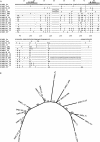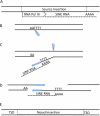Carnivore-specific SINEs (Can-SINEs): distribution, evolution, and genomic impact
- PMID: 21846743
- PMCID: PMC3205823
- DOI: 10.1093/jhered/esr051
Carnivore-specific SINEs (Can-SINEs): distribution, evolution, and genomic impact
Abstract
Short interspersed nuclear elements (SINEs) are a type of class 1 transposable element (retrotransposon) with features that allow investigators to resolve evolutionary relationships between populations and species while providing insight into genome composition and function. Characterization of a Carnivora-specific SINE family, Can-SINEs, has, has aided comparative genomic studies by providing rare genomic changes, and neutral sequence variants often needed to resolve difficult evolutionary questions. In addition, Can-SINEs constitute a significant source of functional diversity with Carnivora. Publication of the whole-genome sequence of domestic dog, domestic cat, and giant panda serves as a valuable resource in comparative genomic inferences gleaned from Can-SINEs. In anticipation of forthcoming studies bolstered by new genomic data, this review describes the discovery and characterization of Can-SINE motifs as well as describes composition, distribution, and effect on genome function. As the contribution of noncoding sequences to genomic diversity becomes more apparent, SINEs and other transposable elements will play an increasingly large role in mammalian comparative genomics.
Figures


Similar articles
-
Analyses of carnivore microsatellites and their intimate association with tRNA-derived SINEs.BMC Genomics. 2006 Oct 23;7:269. doi: 10.1186/1471-2164-7-269. BMC Genomics. 2006. PMID: 17059596 Free PMC article.
-
CAN--a pan-carnivore SINE family.Mamm Genome. 2002 Jan;13(1):50-7. doi: 10.1007/s00335-001-2111-1. Mamm Genome. 2002. PMID: 11773970
-
Occurrence of Can-SINEs and intron sequence evolution supports robust phylogeny of pinniped carnivores and their terrestrial relatives.Gene. 2009 Dec 15;448(2):221-6. doi: 10.1016/j.gene.2009.06.012. Epub 2009 Jun 27. Gene. 2009. PMID: 19563867
-
SINEs.Wiley Interdiscip Rev RNA. 2011 Nov-Dec;2(6):772-86. doi: 10.1002/wrna.91. Epub 2011 Jul 7. Wiley Interdiscip Rev RNA. 2011. PMID: 21976282 Review.
-
SINEs as driving forces in genome evolution.Genome Dyn. 2012;7:92-107. doi: 10.1159/000337117. Epub 2012 Jun 25. Genome Dyn. 2012. PMID: 22759815 Review.
Cited by
-
Genome-wide signatures of complex introgression and adaptive evolution in the big cats.Sci Adv. 2017 Jul 19;3(7):e1700299. doi: 10.1126/sciadv.1700299. eCollection 2017 Jul. Sci Adv. 2017. PMID: 28776029 Free PMC article.
-
Genome-Wide Search Identifies 1.9 Mb from the Polar Bear Y Chromosome for Evolutionary Analyses.Genome Biol Evol. 2015 May 27;7(7):2010-22. doi: 10.1093/gbe/evv103. Genome Biol Evol. 2015. PMID: 26019166 Free PMC article.
-
The reconstruction of evolutionary dynamics of processed pseudogenes indicates deep silencing of "retrobiome" in naked mole rat.Proc Natl Acad Sci U S A. 2024 Nov 5;121(45):e2313581121. doi: 10.1073/pnas.2313581121. Epub 2024 Oct 28. Proc Natl Acad Sci U S A. 2024. PMID: 39467133 Free PMC article.
-
PCR and magnetic bead-mediated target capture for the isolation of short interspersed nucleotide elements in fishes.Int J Mol Sci. 2012;13(2):2048-2062. doi: 10.3390/ijms13022048. Epub 2012 Feb 15. Int J Mol Sci. 2012. PMID: 22408437 Free PMC article.
-
Anti-aging Effects of Alu Antisense RNA on Human Fibroblast Senescence Through the MEK-ERK Pathway Mediated by KIF15.Curr Med Sci. 2023 Feb;43(1):35-47. doi: 10.1007/s11596-022-2688-z. Epub 2023 Feb 20. Curr Med Sci. 2023. PMID: 36808398 Free PMC article.
References
-
- Batzer MA, Deininger PL. Alu repeats and human genomic diversity. Nat Rev Genet. 2002;3:370–379. - PubMed
-
- Belancio VP, Hedges DJ, Deininger P. Mammalian non-LTR retrotransposons: for better or worse, in sickness and health. Genome Res. 2008;18:343–358. - PubMed
-
- Brosius J. Many G-protein-coupled receptors are encoded by retrogenes. Trends Genet. 1999a;15(8):304–305. - PubMed
-
- Brosius J. Transmutation of tRNA. Nat Genet. 1999b;22:8–9. - PubMed
Publication types
MeSH terms
Grants and funding
LinkOut - more resources
Full Text Sources
Research Materials
Miscellaneous

